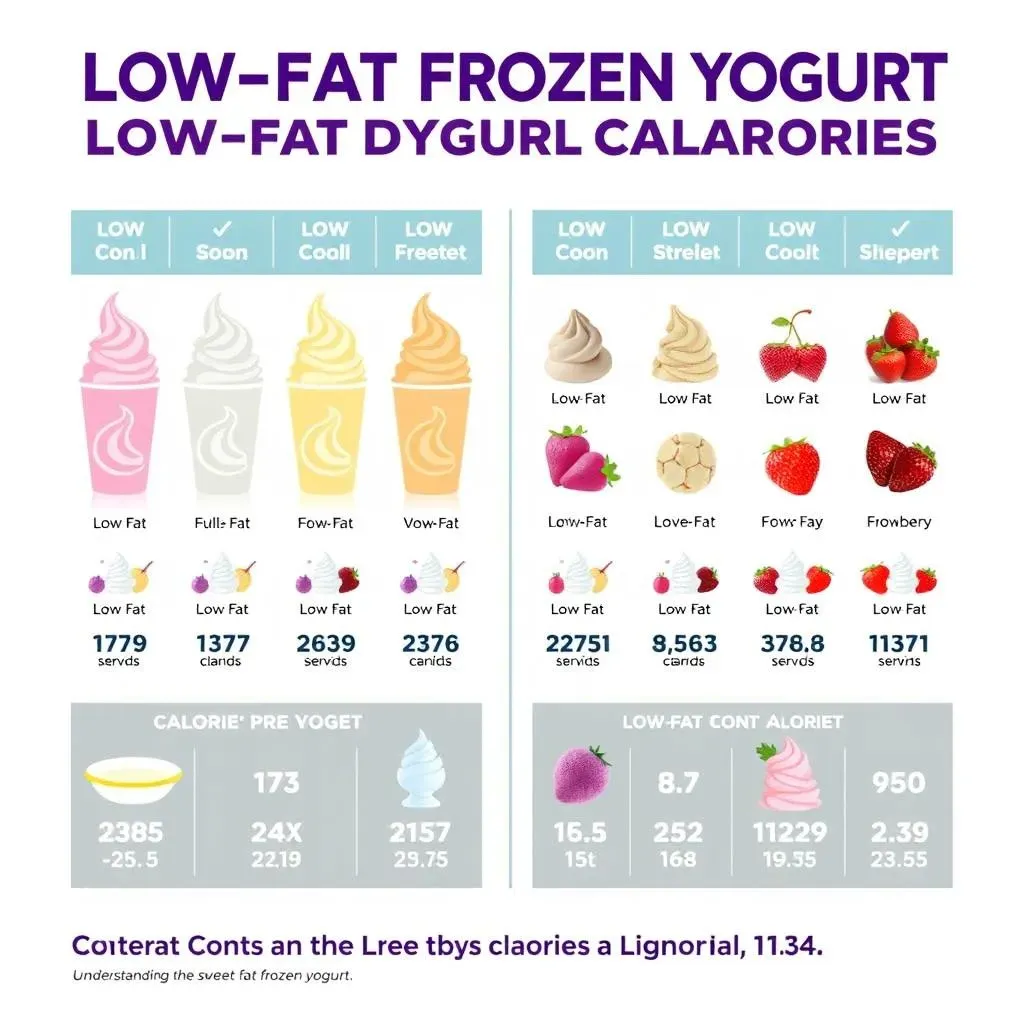Table of Contents
Craving something sweet but trying to keep it light? Low fat frozen yogurt sounds like the perfect solution, right? It's often seen as the "healthy" alternative to ice cream, but how much do you really know about low fat frozen yogurt calories? Are you sure you are making the right choice? This article will break down everything you need to know, from calorie counts to nutritional benefits, and even some sneaky traps to watch out for. We'll explore the calorie content of different types of low fat frozen yogurt and compare them to their full-fat counterparts. I'll help you understand what "low fat" actually means and how it affects the overall nutritional profile. Plus, I'll share some smart strategies for enjoying your froyo without derailing your health goals. Ready to uncover the truth about low fat frozen yogurt calories? Let's dive in!
Decoding Low Fat Frozen Yogurt Calories

Decoding Low Fat Frozen Yogurt Calories
What "Low Fat" Really Means
So, you're staring down a swirling tower of frozen yogurt, and the "low fat" label is practically glowing. But what does it *really* mean? Legally, "low fat" means the product has 3 grams of fat or less per serving. Sounds good, right? But don't be fooled! That doesn't automatically make it a calorie-free zone.
Think of it like this: a regular cookie might have 10 grams of fat and 200 calories. A "low fat" version might cut the fat to 3 grams, but the calories could still be, say, 180. Where did those calories come from? Often, it's sugar! Manufacturers frequently load up low-fat products with sugar to compensate for the flavor lost when the fat is reduced. It's a sneaky trick.
Type of Frozen Yogurt | Calories per 1/2 Cup | Fat (grams) |
|---|---|---|
Regular Frozen Yogurt | 130 | 4 |
Low Fat Frozen Yogurt | 110 | 1.5 |
Non-Fat Frozen Yogurt | 100 | 0 |
The Calorie Breakdown: Beyond the Fat
Now, let's break down those low fat frozen yogurt calories a bit further. As that table shows, you're saving a few calories compared to regular froyo, but not a ton. A half-cup serving typically clocks in around 100-120 calories. Not terrible, but it's easy to go overboard with portion sizes.
And remember that sugar we talked about? It's a major player in the calorie game. Check the nutrition label for the sugar content. You might be surprised to see how high it is! Also, those toppings you pile on? Sprinkles, chocolate sauce, cookie dough... they add up FAST. Before you know it, your "healthy" low fat treat has turned into a calorie bomb.
Low Fat vs. NonFat Frozen Yogurt: What's the Real Difference?

Low Fat vs. NonFat Frozen Yogurt: What's the Real Difference?
Fat Content Face-Off
Alright, let's get down to brass tacks: what *exactly* separates low fat from non-fat frozen yogurt? The big difference, as you might guess, is the fat content. Low fat froyo, as we discussed, has to have 3 grams of fat or less per serving. Non-fat, on the other hand, has virtually no fat – usually less than 0.5 grams per serving.
So, non-fat wins the fat-free prize, hands down. But before you go all-in on non-fat, remember that flavor thing we talked about? Removing fat often means adding other stuff to make it taste good. And that "other stuff" can impact the calorie count and overall healthiness. It's a trade-off, folks.
Beyond the Grams: Sugar, Additives, and More
Don't just fixate on the fat grams! When comparing low fat and non-fat frozen yogurt, you need to be a nutrition detective. Check the sugar content. Sometimes, non-fat versions have *more* sugar than low fat ones to compensate for the lack of richness from the fat.
Also, peek at the ingredient list. Are there a bunch of artificial sweeteners, thickeners, or other additives? These aren't necessarily "bad," but it's good to be aware of what you're putting in your body. Sometimes, a little bit of "real" fat is better than a cocktail of artificial ingredients.
Smart Ways to Enjoy Low Fat Frozen Yogurt Without Overdoing the Calories

Smart Ways to Enjoy Low Fat Frozen Yogurt Without Overdoing the Calories
Portion Control is Your Best Friend
Seriously, this is the golden rule. Those serving sizes on the nutrition label? Pay attention to them! A half-cup might not seem like much, but it's a good starting point. Resist the urge to fill that giant cup to the brim. Instead, use a smaller bowl or cup to help you keep portions in check.
Think about it: would you rather have a small, satisfying serving of froyo, or a huge, guilt-inducing one that leaves you feeling bloated? I know which one I'd choose! And don't be afraid to measure it out at first, just to get a sense of what a true serving size looks like.
Topping Tactics: Choose Wisely
Toppings are where things can really go off the rails. Sure, sprinkles and hot fudge are delicious, but they're also loaded with sugar and calories. Instead, opt for healthier toppings like fresh fruit (berries, bananas, kiwi), a sprinkle of nuts, or a dollop of Greek yogurt.
Get creative! A little bit of shredded coconut or some chia seeds can add flavor and texture without adding a ton of calories. And if you *are* going to indulge in something a little more decadent, like chocolate chips, just use a tiny amount. A little goes a long way!
- Smart Topping Choices:
- Fresh Berries
- Sliced Bananas
- A Sprinkle of Nuts (almonds, walnuts)
- Shredded Coconut (unsweetened)
- Chia Seeds
- A Drizzle of Honey (sparingly!)
DIY Froyo: Take Control
The best way to control what goes into your frozen yogurt is to make it yourself! It's surprisingly easy, and you can customize it to your exact liking. Start with a base of plain Greek yogurt (which is packed with protein and low in sugar), then add your favorite fruits, extracts, or sweeteners.
Freeze the mixture in an ice cream maker, or even just in a freezer-safe container (you'll need to stir it occasionally to prevent ice crystals from forming). Not only will you save calories, but you'll also avoid all those artificial ingredients and additives that are often found in store-bought froyo.
Plus, it's a fun activity to do with kids! Get them involved in choosing the flavors and toppings, and they'll be more likely to enjoy a healthy treat.
Beyond Calories: The Nutritional Perks of Low Fat Frozen Yogurt

Beyond Calories: The Nutritional Perks of Low Fat Frozen Yogurt
So, you've navigated the calorie maze and mastered portion control.
But is there anything *else* to love about low fat frozen yogurt besides its lower calorie count?
Actually, yes!
Believe it or not, froyo can offer some nutritional perks.
The biggest one?
Calcium!
Like regular yogurt, frozen yogurt is a good source of calcium, which is essential for strong bones and teeth.
It also often contains probiotics, those friendly bacteria that are great for your gut health.
However, not all frozen yogurt is created equal.
Some brands might have more calcium or probiotics than others, so it's always a good idea to check the label.
And remember, the benefits are best enjoyed when you're not drowning your froyo in sugary toppings!
The Final Scoop on Low Fat Frozen Yogurt Calories
So, is low fat frozen yogurt a guilt-free indulgence? It can be, if you're smart about it. Knowing the calorie counts, understanding the nutritional differences between types, and practicing mindful toppings are key. Low fat doesn't automatically equal healthy, but armed with the right information, you can enjoy your froyo and stay on track with your goals. Now go forth and froyo responsibly!
